Avete mai provato ad aprire uno dei vostri post su WordPress per poi essere accolti da un errore 404? A volte ci capita quando lavoriamo sui nostri siti WordPress o aiutiamo i nostri utenti a risolvere il problema.
Questo errore si verifica quando si riesce ad accedere all’area di amministrazione di WordPress e al blog, ma quando si cerca di aprire un post specifico, viene visualizzato il messaggio “404 Not Found”.
Può essere frustrante vedere i propri contenuti apparentemente scomparire, ma abbiamo trovato alcune soluzioni per risolvere questo problema. In questa guida completa, vi mostreremo come risolvere i post di WordPress che restituiscono errori 404.
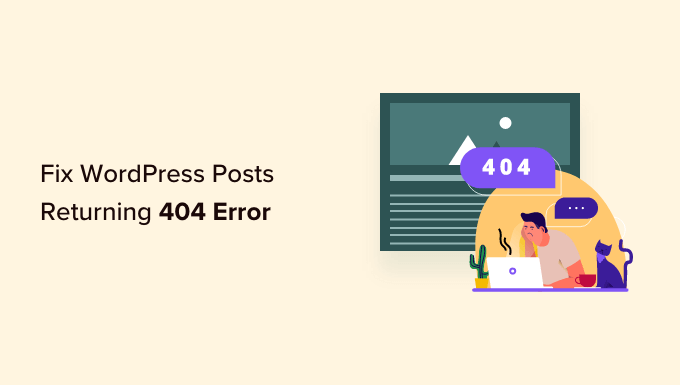
Perché gli articoli di WordPress restituiscono un errore 404?
Ci sono diversi motivi per cui i vostri post potrebbero mostrare un errore 404 “Pagina non trovata” in WordPress. Questi possono essere:
- Conflitti tra plugin o temi: A volte, i plugin o i temi installati sul sito possono interferire con il modo in cui WordPress gestisce i permalink. Ciò può causare la rottura dei colleghi e la comparsa di errori 404.
- Problemi di codice personalizzato: Se avete aggiunto del codice personalizzato al vostro sito web, potrebbero esserci errori nel codice che influenzano i permalink o causano altri conflitti, con conseguenti errori 404 per gli articoli.
- Problemi con il file .htaccess: Il file .htaccess svolge un ruolo nel modo in cui WordPress struttura gli URL. Se questo file è danneggiato o mancante, può causare errori 404 per i post o le pagine.
Come trovare tutti i post di WordPress con errori 404
Prima di passare alle soluzioni, sarebbe bene capire se l’errore si verifica solo in uno o due post o in più post. In questo modo, è possibile determinare la portata del problema e scegliere la soluzione più appropriata.
Un modo semplice per scoprirlo è utilizzare Google Search Console. Se non avete ancora inviato il vostro sito a Google Search Console, leggete la nostra guida su come aggiungere il vostro sito WordPress a Google Search Console.
Una volta che il bot di Google ha effettuato il crawling e l’indicizzazione del vostro sito, Google Search Console vi fornirà informazioni dettagliate sulle prestazioni del vostro sito, compresi gli errori 404 che incontra.
Per scoprire quali post restituiscono errori 404, è possibile accedere alla dashboard di Search Console. Quindi, navigate nel report “Pagine” e vedrete un elenco dettagliato di tutti gli errori.
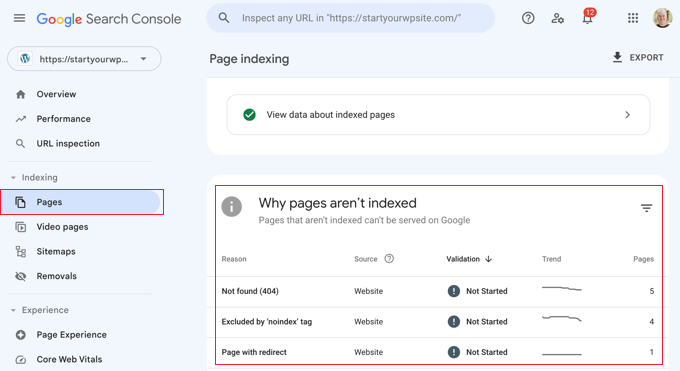
Per ulteriori informazioni, potete leggere il nostro elenco di suggerimenti per l’utilizzo di Google Search Console per aumentare il traffico del sito web, che include alcuni consigli su come risolvere gli errori 404 con lo strumento.
Detto questo, vediamo come correggere gli articoli di WordPress che restituiscono errori 404. Potete usare i colleghi qui sotto per passare direttamente alle diverse soluzioni:
Non avete tempo di risolvere da soli gli errori 404? I Servizi Pro di WPBeginner possono aiutarvi! Con la nostra conveniente Assistenza WordPress d’emergenza, potete assumere esperti per risolvere errori 404, link rotti, problemi di reindirizzamento e molto altro. Smettete di stressarvi per i problemi di WordPress e correggeteli! Programmate oggi stesso un servizio di assistenza WordPress di emergenza!
Metodo 1: Verificare la presenza di conflitti tra plugin o temi e problemi di codice personalizzato
A volte, i plugin, i temi o il codice personalizzato che avete aggiunto al vostro sito WordPress possono interferire con i permalink o causare conflitti, causando errori 404. Lo abbiamo sperimentato anche noi quando stiamo testando gli strumenti sul nostro sito demo.
Un modo per risolvere questo problema è disattivare temporaneamente i plugin. I plugin possono talvolta disturbare il modo in cui WordPress gestisce i colleghi.
Una volta disattivati i plugin, è possibile riattivarli uno per uno, selezionando se l’errore 404 ricompare dopo aver attivato ciascun plugin. Se l’errore compare dopo aver attivato un plugin specifico, il colpevole potrebbe essere quello.
È quindi possibile effettuare una rapida ricerca su Google per trovare soluzioni relative a quel plugin o contattare lo sviluppatore del plugin per ottenere assistenza.
Allo stesso modo, il tema di WordPress potrebbe essere la causa del conflitto.
Per selezionare, è possibile passare temporaneamente a un tema predefinito di WordPress, come Twenty Twenty-Three o Twenty Twenty-Four. Basta andare in Aspetto “ Temi e fare clic su ‘Attiva’ su un tema predefinito.

Se l’errore 404 scompare con il tema predefinito, ciò indica un potenziale conflitto con il tema corrente. Si può quindi provare a risolvere il problema del tema o prendere in considerazione l’utilizzo di un tema diverso.
Potete consultare la nostra selezione di esperti dei temi WordPress più popolari per avere consigli.
Se di recente avete inserito degli snippet di codice nel vostro sito web, potrebbero esserci degli errori nel codice che causano l’errore 404. Esaminate attentamente il codice che avete aggiunto e vedete se riuscite a individuare qualche errore.
Il modo più sicuro per aggiungere frammenti di codice a WordPress è il plugin WPCode. Questo plugin consente di inserire codice personalizzato senza intervenire direttamente sui file del tema, riducendo il rischio di rottura del sito web.
Inoltre, ogni volta che WPCode individua un errore nel codice, disattiva automaticamente lo snippet e chiede di selezionarlo. È anche possibile utilizzare la modalità di test per verificare se il codice funziona prima di inviarlo al sito web.
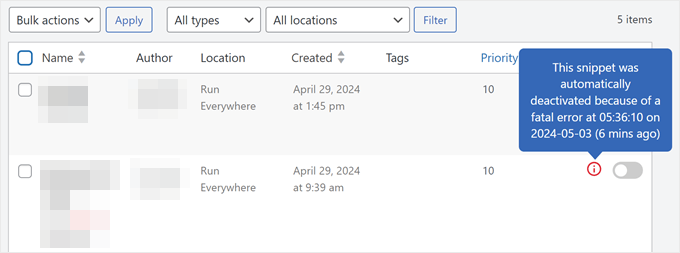
Se nessuna di queste soluzioni funziona, passate al metodo successivo, che prevede la risoluzione dei problemi relativi alle impostazioni dei permalink.
Metodo 2: correggere le impostazioni dei permalink
Gli articoli di WordPress possono restituire errori 404 a causa di problemi con le regole di riscrittura nel file .htaccess. Nella maggior parte dei casi, è possibile correggere il problema aggiornando le impostazioni dei permalink.
Basta andare su Impostazioni ” Permalinks nell’amministrazione di WordPress e fare clic sul pulsante “Salva modifiche”.
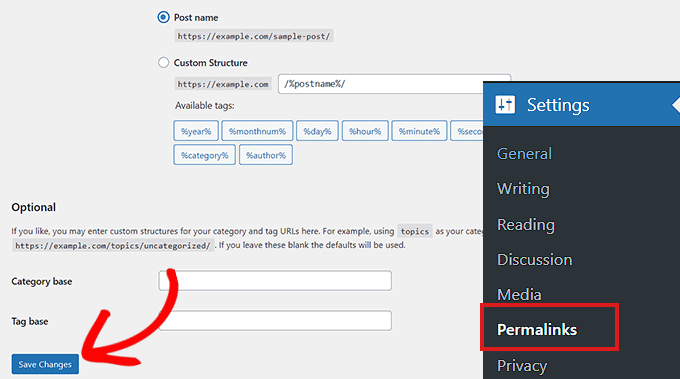
Non è necessario modificare le impostazioni dei permalink. Questa operazione aggiornerà le impostazioni dei permalink e cancellerà le regole di riscrittura.
Nella maggior parte dei casi, questa soluzione corregge l’errore 404 degli articoli di WordPress. Tuttavia, se non funziona, probabilmente è necessario aggiornare manualmente il file .htaccess.
Metodo 3: Aggiornamento del file .htaccess di WordPress
Prima di iniziare, assicuratevi di eseguire un backup del file .htaccess di WordPress. Se qualcosa dovesse andare storto, potrete facilmente ripristinare il file originale.
A questo punto, è necessario connettersi al server utilizzando un client FTP come FileZilla o l’applicazione File Manager nella dashboard del vostro hosting WordPress.
Successivamente, dovrete trovare e modificare il file .htaccess, che si trova nella stessa posizione di cartelle come /wp-content/ e /wp-includes/.
È sufficiente fare clic con il tasto destro del mouse sul file e selezionare “Autorizzazioni file”.
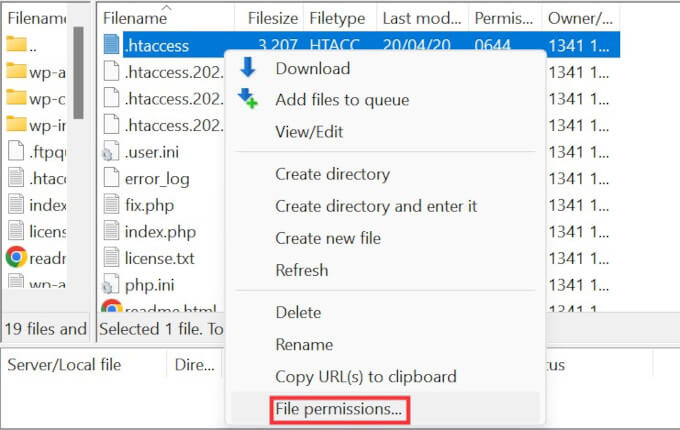
È possibile rendere il file scrivibile cambiando le autorizzazioni a 666.
Inserite semplicemente “666” nella casella “Valore numerico” e fate clic su “OK”.
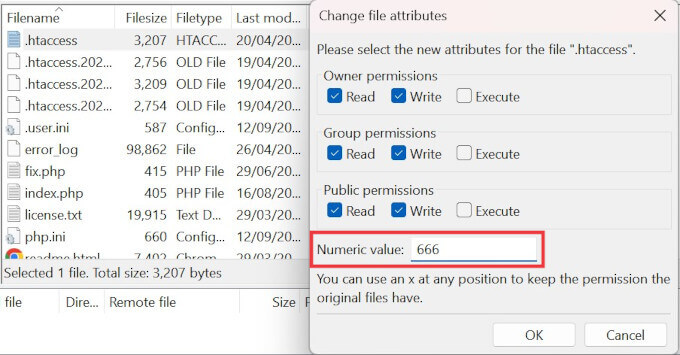
Quindi, è necessario ripetere i passaggi del primo metodo del nostro tutorial. Una volta fatto questo, non dimenticate di modificare le autorizzazioni in 660.
È anche possibile modificare il file e aggiungervi del codice.
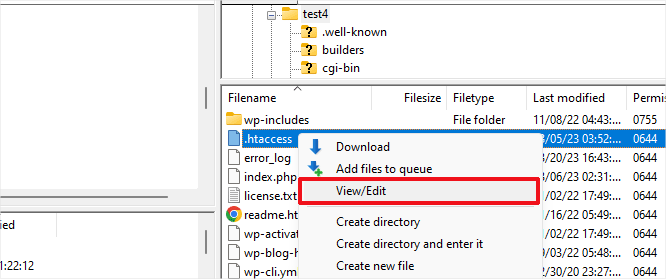
Una volta aperto il file .htaccess con un editor di testo, è sufficiente inserire questo codice:
# BEGIN WordPress
<IfModule mod_rewrite.c>
RewriteEngine On
RewriteBase /
RewriteRule ^index\.php$ - [L]
RewriteCond %{REQUEST_FILENAME} !-f
RewriteCond %{REQUEST_FILENAME} !-d
RewriteRule . /index.php [L]
</IfModule>
# END WordPress
Metodo 4: contattare il fornitore di hosting
Se nessuna delle soluzioni sopra descritte ha corretto l’errore 404 degli articoli di WordPress, vi consigliamo di contattare il vostro fornitore di hosting WordPress. Potrebbe trattarsi di un errore on loro, oppure potrebbero aiutarvi a risolvere il problema.
NON SI TRADUCE la nostra guida su come richiedere correttamente l’assistenza WordPress e ottenerla.
Metodo 5: Abilitare il mod-rewrite (installazione locale di WordPress)
Se si utilizza un server locale a scopo di test, è necessario abilitare il mod_rewrite nella configurazione Apache del sito MAMP, WAMP o XAMPP.
Questo permetterà a WordPress di generare URL puliti e di evitare l’errore 404 per articoli e pagine sul server locale.
Il modo in cui farlo varia a seconda della piattaforma utilizzata. Chi usa XAMPP può aprire il proprio pannello di controllo e fare clic sul pulsante “Config” all’interno di Azioni. Quindi, selezionare “Apache (httpd.conf)”.
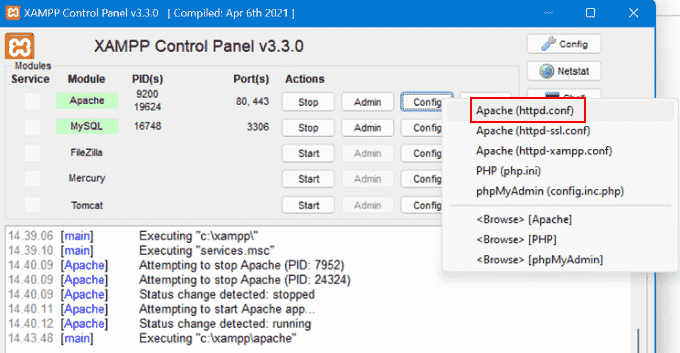
Successivamente, è necessario trovare questa riga #LoadModule rewrite_module modules/mod_rewrite.so e rimuovere il ‘#’ per decommentarla.
Questo caricherà il mod_rewrite.
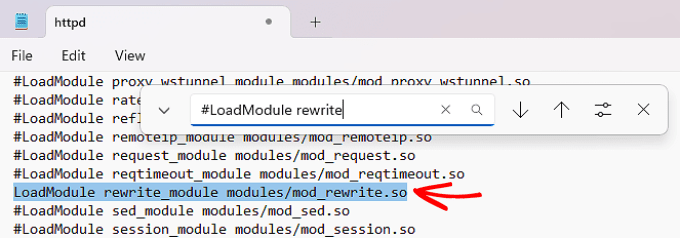
Quindi, individuare tutte le istanze di AllowOverride None e modificarle in AllowOverride All.
Il valore “Tutti” significa che tutte le direttive possono essere sovrascritte.
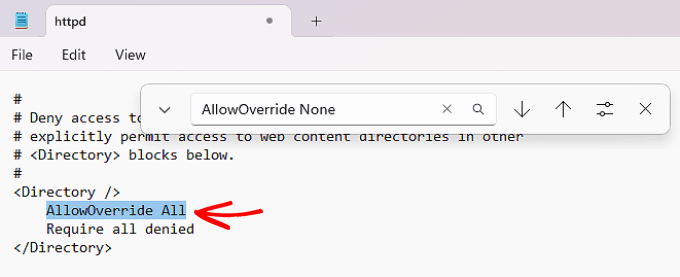
Una volta fatto, si può salvare il file httpd.conf e chiuderlo. Dopodiché, nel pannello di controllo di XAMPP, fate clic su ‘Stop’ sul modulo Apache e su ‘Start’ per riavviarlo.
Poi, tornate alla vostra Bacheca per vedere se i permalink funzionano.
Video tutorial
Se avete bisogno di istruzioni visive, guardate il video qui sotto.
Speriamo che questo articolo vi abbia aiutato a risolvere i post che restituiscono errori 404 in WordPress. Potreste anche voler consultare la nostra guida agli errori più comuni di WordPress e a come risolverli, insieme alle scelte dei nostri esperti sui migliori plugin WordPress per far crescere il vostro sito.
Se questo articolo vi è piaciuto, iscrivetevi al nostro canale YouTube per le esercitazioni video su WordPress. Potete trovarci anche su Twitter e Facebook.





Moinuddin Waheed
This is one of the most occuring error for wordpress websites.
this is really frustrating as it seems to get stuck and leading to nowhere.
I have solved the issue by saving the permalink.
I didn’t know about the other steps.
I really appreciate the efforts to make it holistic by including all the steps to resolve this error.
WPBeginner Support
Glad we could share the other options
Admin
mohadese esmaeeli
Hello. The 404 error can be really frustrating, and we’ve all encountered it at least once. The situation becomes challenging when everything appears to be correct, there are no broken links, yet the 404 error persists. I faced this issue once, and it was resolved by adjusting the permalink settings.
amir
Hi
in my case, a plugin named as “WebP Express” create a htaccess file in uploads folder that restrict my access to some images.
try rename or remove it and see if the problem still exist.
WPBeginner Support
Thank you for sharing this suggestion to check for multiple htaccess files.
Admin
Eriab Nsereko
Syed & the team u saved my whole entire day! My homepage was actually loading well.. but the other pages couldn’t load. So, I pasted the code in my .htaccess file and it did absolutely like magic.
# BEGIN WordPress
RewriteEngine On
RewriteBase /
RewriteRule ^index\.php$ – [L]
RewriteCond %{REQUEST_FILENAME} !-f
RewriteCond %{REQUEST_FILENAME} !-d
RewriteRule . /index.php [L]
# END WordPress
WPBeginner Support
Glad we could help!
Admin
David Helleskov Fønsbo
Thanks – None of the suggested solutions did work for me. Looks like the typical permalink error but it isn’t.
Saving permalink again does not create a new .htaccess.
WPBeginner Support
If none of the methods in our guide are working for you, please reach out to your hosting provider and they should be able to help fix the issue.
Admin
Victor
The updating permalinks fix worked. Fastest solution ever. Thank you for writing this piece
WPBeginner Support
You’re welcome, glad our guide was helpful!
Admin
Julie
Thank you for the quick fix! Appreciate the help.
WPBeginner Support
You’re welcome, glad our guide could help you!
Admin
Frank Thomas
Thank you for this post. I was missing the .htaccess files after moving sites and of course the wordpress code in them. I’ve replaced it all and voila! We are live at 5. Thanks.
WPBeginner Support
You’re welcome, glad to hear the guide helped!
Admin
anand
i have try to your guideline but not working my website again showing same error 404
WPBeginner Support
If none of the recommendations from our guide could solve your error, please reach out to your hosting provider and they should be able to take a look and help!
Admin
Harald
Hi,
saving permalink helped me too, but it keeps returning over and over again after some days.
I have no clue what causes it.
WPBeginner Support
If it is a constantly recurring error, we would recommend reaching out to your hosting provider and they can either look at their error logs for the site or keep an eye on your site for the specific error causing the problem.
Admin
Mete
Thank you very much.solved my problem
WPBeginner Support
Glad our guide was helpful!
Admin
Emmanuel
This is my lifesaver. My site is working fine after modifying the .htaccess files.
Thanks a ton!
WPBeginner Support
Glad our guide could help!
Admin
Jon
For me the problem was I forced a redirect from mydomain.com to ww.mydomain.com, but in wordpress the site URL said mydomain.com. After changing the redirection to ww.mydomain.com -> mydomain.com everything worked.
WPBeginner Support
Thanks for sharing this for those who may also have this issue!
Admin
Mario Nwolisah
Thank you! It worked. I really appreciate.
WPBeginner Support
Glad our article was helpful!
Admin
Jess
Thank you – this saved me!
WPBeginner Support
Happy to hear our guide could help!
Admin
Cristian
Thank you, it works for me!!!
WPBeginner Support
Glad our recommendations were able to assist!
Admin
Samir K Al Busaidy
I was panicking and thinking that my website was hacked or had malware. As I read your writing and you wrote not to worry, I began to relax. The first option (permalink) worked for me immediately…
Thanks
WPBeginner Support
Glad our guide was able to help
Admin
Udaykumar Posia
This worked. Thank you so much.
WPBeginner Support
Glad our guide could help
Admin
Max Legault
On IIS there is no .htaccess file but the key is still the permalink settings. Just hitting Save didn’t fix it but changing the Custom Structure to Plain worked like a charm. Thanks for the push in the right direction.
WPBeginner Support
Glad you were able to find the solution for your issue
Admin
Collin
I love you for this! This was an easy fix. I was in full panic mode!
WPBeginner Support
Glad our guide was able to help
Admin
Zack
Thank you so much. It worked!
WPBeginner Support
Glad our guide was helpful
Admin
Steve Barnard
Dang! Can’t thank you enough for this – super simple fix worked perfectly – just hit save changes on the permalinks settings page and viola’ – my pages are back. Thank you!!
WPBeginner Support
Glad our guide could help
Admin
A.S.M. Arifur Rahman
Thanks a lot, settings saved method works, Now my post open fine.
kris
honestly thank you so much! without fail your site always comes thru with answers that work. thank you so much!
(now I just wish I knew what caused it to get out of whack in the first place. oh well.)
Chris
This article just saved me from a panic attack Lol. The solution worked great. Thanks for making this video.
Muhammad Tahir
i didn’t solve this issue by using all the methods that you are discussed?
WPBeginner Support
If none of our methods in this guide worked for you, we would recommend reaching out to the support for your hosting provider to ensure there is not an error on their end.
Admin
Duane Wiese
None of the above suggestions worked so I did some further searching. I came across someone who suggested switching off the mod security under the security section in cpanel.
I tried this and it worked. I also tested it by switching it back on after a change and then trying another change and BAM, 404 error.
WPBeginner Support
Thanks for sharing this should someone else run into this issue. Not every host allows access to that specific file but if you reach out to your host they can normally disable or change it for you
Admin
Dave Emma
Disabling ModSecurity fixed mine.
I actually tried permalinks plus rewriting .htaccess, but that didn’t solve my problem. I’m glad I read comments. Many thanks guys for sharing.
Elango
Thanks, it was so simple and the problem solved. No other pages were visible after I migrated to another server. I added the lines to .htaccess file and uploaded the same. Now all the pages are being displays without the 404 error and I am able to access my WP dashboard too. Thanks a lot.
WPBeginner Support
Glad our guide was able to help
Admin
Islombek
My posts are showing 404 error after installing ssl certificate. How can I fix it? I tried everything mentioned above, but none helped.
WPBeginner Support
If you are changing your site’s URL to HTTPS you would want to follow our guide below:
https://www.wpbeginner.com/wp-tutorials/how-to-add-ssl-and-https-in-wordpress/
Admin
Dennis Yildirim
My .htaccess file is exactly the same with that code but nevertheless I did whatever in the post. did not work, saved permalinks through admin console, did not work. Manually edits, no luck. Deleted the .htaccess and recreated it by saving it from admin console, again did not work. Nothing works. Don’t know how did it even work on others?
WPBeginner Support
If none of the recommendations from our article were able to help we would recommend reaching out to your hosting provider as that can be a sign that there is an issue on your host’s end.
Admin
Kuldeep Singh
You saved my day. I got this issue after transferring my site from one hosting to another. I couldn’t believe it was so simple to fix the issue. Many Thanks WpBeginner team!
WPBeginner Support
Glad our guide was helpful
Admin
Rick
I never reply to these things but just wanted to jump on here and say thank you! I’ve been having this issue a lot and having to wait ages for support to help me and so finally had a hunt around, found this, and can now fix it myself. You legend!! Much appreciated
WPBeginner Support
Glad our guide was helpful
Admin
Elroy
Thanks a lot Wpbeginner it woked just fine.
WPBeginner Support
Glad our guide was helpful
Admin
Noble
Thank you very much, it worked instantaneously!
WPBeginner Support
Glad our guide could help
Admin
carol hannah
Help! It didn’t work and I can’t possibly work out how to do the .htaccessfile thingy?
WPBeginner Support
You would either need to use FTP which we cover on the page below:
https://www.wpbeginner.com/glossary/ftp/
Or reach out to your hosting provider and they would be able to assist.
Admin
Christopher Krohn
Thank you, thank you, thank you!
WPBeginner Support
Glad our guide was helpful
Admin
Dan
Man this fixed my WP site! THANK YOU!
WPBeginner Support
Glad our guide was helpful
Admin
Molly
Thank you for a million time!!!!!
WPBeginner Support
Glad our guide was helpful
Admin
Amin Omer
Thank you very much
WPBeginner Support
You’re welcome
Admin
Afan
One of solutions to correct the issue with the Permalink change is simply delete the .htaccess file – WordPress will recreate it again automatically.
But, before you delete it, copy the file on your computer, just in case…
WPBeginner Support
If someone has customized their htaccess file then that would be a good idea. Otherwise, WordPress should auto regenerate the default information in the file where most wouldn’t need to worry.
Admin
James Monroe
Saving the permalinks settings worked perfectly. Such a simple solution to what looked like a serious problem! Thank you!
WPBeginner Support
Glad our recommendation was helpful
Admin
mukhtar
its works fine 100 %
and easy to solve my problem, we are very very thankful to you about it
WPBeginner Support
Glad our guide was helpful
Admin
Sarah
Wow!! I’ve spent all evening trying to fix this and that’s how easy it was! THANK YOU!!
WPBeginner Support
Glad our guide was helpful
Admin
Rimzan farook
Thanks fixed it as you described changed my post date to post name, thanks a ton
WPBeginner Support
Glad our recommendations could help
Admin
Muhammad Zeeshan
I’m facing 404 error while adding new plugin , theme , editing any post or product, editing any page ..
I’ve try to save permalinks and also tried to change .htaccess .. But not this given solution is working for me.
WPBeginner Support
You would want to reach out to your hosting provider to see if you are running into any errors on their server’s end.
Admin
Ayobami
I’m having error 404 issues on my website, I can’t access to the website at all what can I do?
WPBeginner Support
You would use the htaccess method from this guide or reach out to your hosting provider to be able to assist you
Admin
samith
I can’t login my WP dashboard seen “nginx 404 not found error”
WPBeginner Support
For that specific error, you would want to reach out to your hosting provider to take a look.
Admin
Sammy
A BIG Thank You… It solved the headache!
WPBeginner Support
Glad our guide was helpful
Admin
Mihir
I’m facing a problem where this is extension of my own website after every page and I don’t know how to fix it.
WPBeginner Support
You would likely want to check under Settings>Permalinks to ensure everything is set correctly there
Admin
Daniel
Thank you,
It solved my problem!
WPBeginner Support
Glad our guide was helpful
Admin